Picto Diary - 29 September 2015 - Somme
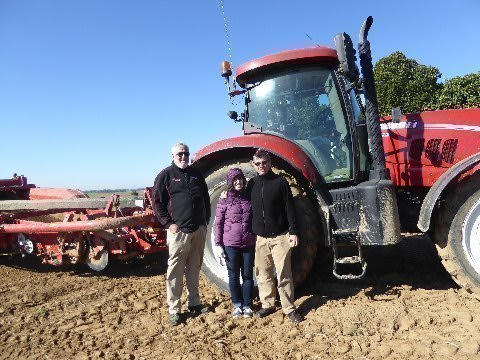
Above: The Bishop, Portland, and Rudy Jr. standing in front of a potato harvester near Sucrerie Military Cemetery, Somme WWI battlefield, Oise (7 miles north of Albert, France), France. 29 September 2015.
Post WWI the Somme battlefield, formerly farm land, was so scarred that authorities were on the point of turning the area into a forest. French farmers, however, came back to their holdings and pleaded with authorities to have the land restored to its former state. This was done. Roads, lanes, copses, and forested areas now exist more or less in the same configuration as before the war. Battle artifacts are regularly unearthed by farmers using equipment such as that pictured. The artifacts are placed in designated areas by the side of the road and periodically picked up by government agencies who manage the French and Commonwealth cemetery network in the area. Our guide, Patrick, notes that artifacts are still regularly unearth 100 years later... and that, probably no more than 5% of the war debris that remains along the Western Front, has been retrieved.
The battle of the Somme, fought by the French and the British against the Germans, took place between 01 July 1916 and 18 November 1916 on both sides of the Somme River, on the Western Front, Oise, France. It was one of the largest battles of WWI, in which more than 1MM men were wounded or killed, making it one of the bloodiest battles in human history.
The first day of the Somme offensive, 01 July 1916, resulted in nearly 60K British casualties, greater than the total combined British casualties in the Crimean, Boer, and Korean wars. By the time the offensive ended in November, the British had suffered 420K casualties (60K dead).
A Franco-British commitment to an offensive on the Somme had been made during Allied discussions at Chantilly, Oise, in December 1915. The Allies agreed upon a strategy of combined offensives against the Central Powers in 1916, by the French, Russian, British and Italian armies, with the Somme offensive as the Franco-British contribution. The main part of the offensive was to be made by the French Army, supported on the northern flank by the Fourth Army of the British Expeditionary Force (BEF). But, the Germans struck first... not at Somme, but, at Verdun, 140 miles further south on the Western Front, in February 1916. French troops anticipated as part of the Somme offensive, had to be diverted to Verdun leaving the bulk of Somme fighting to the British. The Battle of the Somme is iconic in British military history.
Our tour started at Gommecourt at the far north end of the battlefield. Here, the British effort got off to a bad start. On the far north of the field, the British 46th Division, under the command of Major General Stuart-Wortley, was to break into the German third line and meet up with the 56th Division coming up from the South. Stuart-Wortly, noting the terrible casualty rate being suffered by his boys, called off the attack. This resulted in the 56th Division, which pursued its orders, suffering greater casualties than it would have otherwise been the case had 46th done its job.
Scandal. Enter Lt. General James Snow, Commander VII Corps, and Stuart-Wortley's boss. Snow is livid that Stuart-Wortley has not pursued his attack and cashiers his subordinate, mid battle, on the spot. Stuart-Wortley returns to Great Britain in disgrace, and the 46th Division is held in contempt by British soldiers throughout the campaign... until 1918, when they finally distinguish themselves in battle. Ironically, it was the 46th Division that had fought so well in capturing the Hohenzollern Redoubt at the Battle of Loos, in September of 1915, which battlefield we visited yesterday, 28 September 2015.
On a sunny, but windy and cool morning, our battlefield guide, Patrick, showed us tour goers, at the north end of the Somme battlefield, where the 46th and 56th British Divisions launched their assault at 6:00 AM on 01 July 1916. Patrick, ably, with passion, and in detail, told the story of Stuart-Wortley's shame. He took us to three vantage points to see the Gommecourt section of the Somme battlefield: a British forward artillery observation bunker, the spot pictured above, Sucrerie Military Cemetery, and Gommecourt Military Cemetery.
Note: Russia fulfilled its part of the agreement made at the 1915 Chantilly conference. In June 1916, she launched the Brusilov Offensive, her greatest feat of arms during WWI. It was one of the most lethal offensives in world history. Historian Graydon Turnstall called the Brusilov Offensive the worst crisis of WWI for Austria-Hungary and the Triple Entente's greatest victory. Victory came, however, with tremendous loss of life.
Russia would be out of the war in early 1918 with the take over by the Bolsheviks. The Bolsheviks consummated with Germany the treaty of Brest-Litovsk which ended Russia's participation as a member of the Triple Entente and hence her fighting. Following Russia's exit from the war, what seemed an opportunity for Germany to concentrate all her energies on the Western Front was rebuffed by the United States' entrance into the war.
With revitalized energy for the allies coming from the United States, Germany, exhausted, sued for peace. The war ended with the signing of the Armistice at Versailles on 11 November 1918.

Above: The Bishop. Serre Road #2 British Cemetery. Somme battlefield. France. 29 September 2015.
July 1916... a bit of context. Gallipoli, an Allied effort to force the Dardanelles, has been a fail... Allied troops were successfully evacuated from Gallipoli by January 1916. Many of the Gallipoli evacuees were redirected to nearby Salonica to mount a resistance to German assisted Austro Hungarian assaults on Serbia.
I spent two weeks touring the Gallipoli battlefield in June of this year (2015).
It is satisfying while I tour the Western Front to now be able to place the Gallipoli initiative in broader context. For example, Neuve Chappel was fought only a couple of weeks before the British/ANZAC Gallipoli landings in April of 1915. Loos was fought only a month after the mishandled landing at Suvla Bay in August 1915.
The failed Gallipoli invasion, urged by the Russians, and initiated by the British, cost 250K allied casualties.

Above: WWI battlefield tour group near Gommecourt, listening to battlefield guide Patrick Mercer describe 46th and 56th Division attacks at the north end of the Somme battlefield. 29 September 2015.

Above: Corner brasserie, Albert, France. 29 September 2015.
Our lunch spot today... and not atypical of many of the places we stopped to eat on our tour.
Lunch and dinner were our responsibility, not included in the cost of the tour. We ate serendipitously, often walking out of our hotel to look for the first decent place. Consequently, for the most part we ate pub (brasserie) food. Steaks, omelets, roast chicken and fries. Not bad.... not fine dining either.
Anyone taking a tour like ours who wanted to include fine dining would have to get a Michelin Guide and do some pre-planning.

Above: French WWI regular soldier uniform 1914-1915. Somme 1916 Museum, Albert, France. 29 September 2015.
It is amazing that French soldiers started fighting WWI wearing virtually the same uniform French soldiers wore during the Napoleonic period, 100 years previously. The uniform was worn in the Franco / Prussian war of 1870.
France introduced a new light blue, wool uniform - "horizon blue" in late 1915. British wore khaki and Germans wore a dull gray colored uniform
The Somme 1916 Museum occupies what was originally the crypt beneath the basilica. The crypt was used as an aircraft raid shelter in WWI. Alcoves show scenes of trench life during WWI. In addition to showing original uniforms, the exhibits have show-cases containing quantities of weaponry and other war materials rescued after the war from the surrounding fields and old trenches.

Above: Colt 45, 1911 ACP pistol found on the Somme battlefield. Somme 1916 Museum. Albert, France.
This fire arm is still widely used today. I shoot my own 1911 ACP periodically at a local firing range.
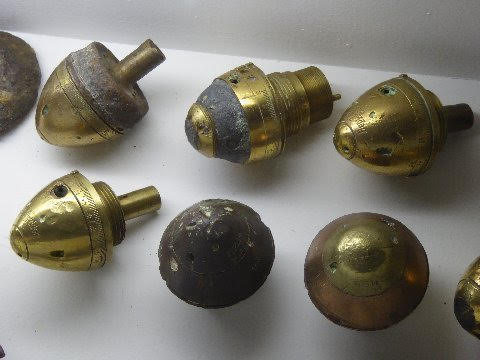
Above: WWI shrapnel shell fuses. Somme 1916 Museum. Albert, France. 29 September 2015.
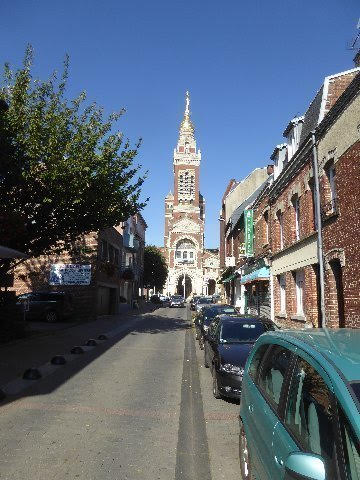
Above: Albert Basilica. Albert, France. 29 September 2015.
During the systematic destruction of the town of Albert in 1914, the bell tower of the Basilica of Notre-Dame de Brebieres was at first spared, but after November 1914 it became the object of shellfire attacks.
The large statue of the Virgin holding up the infant Jesus on top of the tower was unharmed for a while. However on 15 January 1915, a shell hit the base, bending the dome that supported the statue so that it leaned over, hanging precariously at right angles over the town.
On 16 April 1918 the statue finally fell. Nicknamed the "leaning Virgin," the statue became the object of superstition among the soldiers.
The statue was restored to its rightful place after the war.
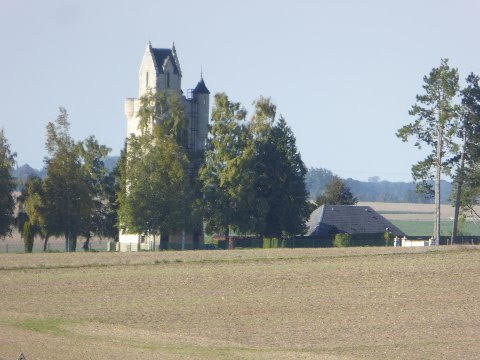
Above: Ulster Tower memorial. Somme battlefield. Thiepval, France. 29 September 2015.
Ulster Tower was built in 1921 using funds raised from fund raising activities in Ulster. It is a replica of another tower built on the estate of Lady Helen Duffenin in Clamboye, Northern Ireland, where soldiers from the 36th Irish division underwent their training.
The monument was erected in the memory of the Irish who fought in the Battle of the Somme and also commemorates all Ulster soldiers who died during the Great War.
Pre-war Ireland, part of the United Kingdom before WWI, was on the verge of a civil war. The strife was suspended when Britain entered the war. Irish troops joined in the British war effort and fought valiantly in WWI.
Post war, between 1919 and 1921 pre WWI hostilities broke out again in the Irish War of Independence, fought between British security forces in Ireland and the Irish Republican Army.
In the December 1918 election, The Irish republican party Sinn Fein won a landslide victory in Ireland. In January 1919 Sinn Fein formed a breakaway government and declared independence from Great Britain.
Conflict began when two members of the armed police force, the Royal Irish Constabulary (RIC) were shot dead in County Tipperary by IRA members acting on their own initiative. This is often seen as the beginning of the conflict.
The conflict escalated with IRA members ambushing RIC and British army patrols. The British government bolstered the RIC with recruits from Britain - the Black and Tans and Auxiliaries - who became notorious for ill-discipline and reprisal attacks on civilians.
The Anglo-Irish Treaty was signed on 6 December 1921. This treaty ended British rule in 26 counties of Ireland, and, after a ten-month transitional period overseen by a provisional government, the Irish Free State was created as a self-governing state with Dominion status. Six north eastern counties remained within the United Kingdom.
Battlefield guide Patrick Mercer, who served much of his career as a senior British military officer in northern Ireland, laments the loss of regimental traditions of the Irish regiments who fought in WWI. Northern Ireland WWI regimental traditions have been sustained.
Patrick, with years of experience as a military officer in Northern Ireland, feels that sectarian problems in northern Ireland have not gone away and will "rear their ugly head" in the short term.
The Balkans, where the fuse was lit for WWI, is another area where sectarian feelings seethes not far from the surface today.

Above: Monument to 18th Division, Thiepval, France. 29 September 2015.
There were three British armies in WWI. The storied professional army... the first fighters in WWI... "The Old Contemptibles." The new army made up of members of the Territorial Force (TF) and new recruits responding to Kitchener's "I want you" recruiting campaign. Finally, later in the war, was the conscripted army.
The 18th Division, memorialized here, was a "new army" division. The Somme was the first WWI battle where new army divisions fought.
By the end of the war, Britain had raised an army of over 4MM soldiers.
I don't have a count.... but, monuments like this are prolific throughout the Western Front areas we have visited.
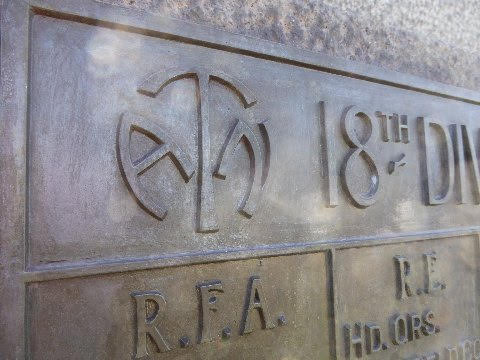
Above: Close-up of "flash" or patch of the 18th Division of the new army on brass plaque of 18th Division Somme monument, Thiepval, France. 29 September 2015.
The 18th Division, made up of volunteers and Territorial Forces, was a newly created Division. It had no Divisional or regimental traditions in British military history. So, the Division had to come up with its own flash (patch). Look carefully... you can determine the connection of the flash to the 18th.
As British forces had been depleted by casualties in the 1914 and 1915 battles, the new army... poorly trained as it was, needed to step up to the fighting. The first test of the new army was at Somme.
Addendum:
Have you uncovered who won WW1?
Vegas,
Park City, UT
We. Just had s delightful evening with David A.
He gave me a copy of ADM Ashworth autobio
I was his aid for a year and it was great to talk about his father
Thanks for connecting us.
Cheers
D. Walker,
San Diego, CA
Hi Steve!
This is a long shot but does the name "Moe Berg" ring a bell with you? -- particularly connected with Les Deux Magots and the Sorbonne?
I am giving a talk in ten days to a WWll study group at Vanderbilt in Nashville, including a contact between Moe as a spy for the OSS and Werner Heisenberg (head of any atomic bomb program in Germany). Moe carried a pistol and a vial of cyanide with him at a meeting in Zurich and was directed to kill Heisenberg (and then commit suicide) in case he came to the conclusion that Germany was well advanced in any bomb program. The conclusion was negative and greatly relieved the Manhattan Project program in December 1944.
Moe graduated from Princeton in Modern Languages (spoke seven fluently) but because of his interest and talent in baseball he immediately joined the Big Leagues as short stop for Brooklyn. After that first of twelve seasons in 1923, he went to Paris for the off-season and supposedly signed up for 20 courses at the Sorbonne where he was conspicuous for reading ten different International newspapers daily.
I can imagine that he must have spent considerable time at Les Deux Magots!
A long shot I know but any pertinent comments?
Manhattan,
Park City, UT
Thanks for sharing, much appreciated.
LaDoc, LaPsy,
Los Angeles, CA
Dear Chitta. You are a wonderful addition to Steve's forum. I really appreciate your very thoughtful inputs even if I don't always agree with you.
Regards,
Nathans,
Massapequa, NY
....The thanks are truly to Steve, for his immense note-taking powers and for his patience in expending what must have been a lot of time and effort into transcribing those notes and posting all those details of his travels.
It's been a long time since I thought much about World War I battles. it was good to be reminded that there some things we should not forget.
Chita,
Vancouver, BC